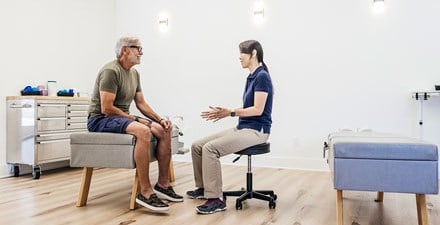
Falls are common in people over 65 years of age. A fall can result in unwanted outcomes, including injury, loss of independence, and decreased ability to do the things that are most important to you. They also can result in death.
According to the Centers for Disease Control and Prevention, 3 million older adults are treated in the emergency room for fall injuries each year. The average health care cost per fall is $35,000.
The good news is falls are preventable. Balance training is an important and effective part of falls prevention. Performing safe home exercises can help strengthen your lower body to promote balance and reduce your overall fall risk, among other health benefits. According to the Journal of the American Geriatrics Society, physical activity, including exercise, reduces falls by 13% to 40% in community‐dwelling older adults.
A physical therapist can evaluate your balance and recommend appropriate exercises that are tailored to your specific needs and goals and are safe for you to perform at home. Physical therapists are movement experts who improve quality of life through hands-on care, patient education, and prescribed movement.
Here are some exercises your physical therapist might recommend:
Always check with your health care provider before beginning a home exercise program. For safety during these exercises, position yourself near a countertop or sturdy surface that you can use for support.
1. Standing Step Training
Start in a standing position facing a countertop or other stable surface in front of you. Place your feet side by side pointing toward the counter and ensure you have enough room to step forward, to each side, and behind you safely. Imagine a large clock face on the floor with 12, 3, 6, and 9 o'clock positions marked. Have a friend or family member call out the clock positions randomly. Quickly step to the corresponding "hour" on the clock face. This will help to challenge your balance and reaction time.
2. Standing 3-Way Kicks
Standing on 1 leg (with a soft, unlocked knee), slowly raise your other leg out in front of you. Keep your extended leg as straight as possible and return it to the center. Then gently lift the same leg out to the side and back down, and then extend your leg behind your body and back down. Perform as many as you can each way. Your physical therapist may increase the difficulty of this exercise by removing the supporting surface.
3. Sidestepping
Facing a countertop or wall (with your hands on the counter or wall for support as needed), step sideways in 1 direction with your toes pointed straight ahead until you reach the end of the wall or counter. Then, return in the other direction. As this becomes easier, a physical therapist may add in the use of a resistance band at the knees or just above the ankles.
4. 1-Leg Stand
Stand on 1 leg as long as you are able, up to 30 seconds. Remember to remain near a sturdy support surface that you can hold on if needed. Alternate legs and try to do this 3-5 times on each leg. As this becomes easier, challenge yourself by doing other tasks while standing on 1 leg, such as brushing your teeth, talking on the phone, or while doing the dishes. Balance exercises can easily be integrated into your daily routine this way.
5. Sit to Stand and Stand to Sit
Rise out of a chair without using your arms to push up. If this is difficult at first, place a firm pad underneath you on the chair seat to raise you. As you return to a seated position, slowly lower yourself all the way back down and ease into your seat (rather than dropping into the chair). Perform as many times as you are able. This can easily be done while watching TV.
6. Heel-to-Toe Standing or Walking
Place 1 foot directly in front of the other, so the heel of the front foot touches the toe of the back foot. Hold this position for as long as you are able, or up to 30 seconds. As this becomes easier, try taking a few steps in this heel-to-toe format, as if you are walking on a tight rope. Remember to use something to hold on to for safety.
Many factors can contribute to a lack of balance and falling. Older adults, especially those who have experienced dizziness, stumbling, or falls, should obtain a comprehensive evaluation from a PT or another qualified health professional. Some physical therapists specialize in balance and falls management.
You can contact a physical therapist directly for an evaluation. To find a physical therapist in your area, visit Find a PT.


